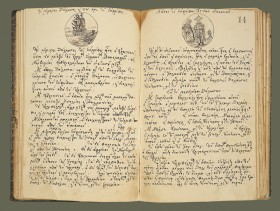IV.3å. Ôhe polymorphism of the 18th century
In the 18th c. the community of the Romioi entered a new historical phase. The pre-eminent social groups are the Phanariots, the clergy of the Patriarchate and the local nobility. A new factor is the emergence of a strong merchant class. Its members, together with a small number of Phanariots, priests and scholars led the way (c.1770-1820) in promoting the ideas of the European Enlightenment, which led to conflict with the Church. Ecclesiastical commissions still predominated in the fine arts. Artistic forms were mainly based on Byzantine tradition, while combining various European and Islamic elements. Then another type of painting, with secular subject matter, burst on the scene, and was used to decorate the houses of wealthy merchants, sometimes even churches. Shortly before 1821 certain parts of the Greek population were in the most active phase of their early urbanization.
-

Painted panel with the sacrament of Confession
BXM: 001322
Exhibition room: IV.3å Ôhe polymorphism of the 18th century
details -

Geography, paper manuscript
BXM: 019758
Exhibition room: IV.3å Ôhe polymorphism of the 18th century
details








